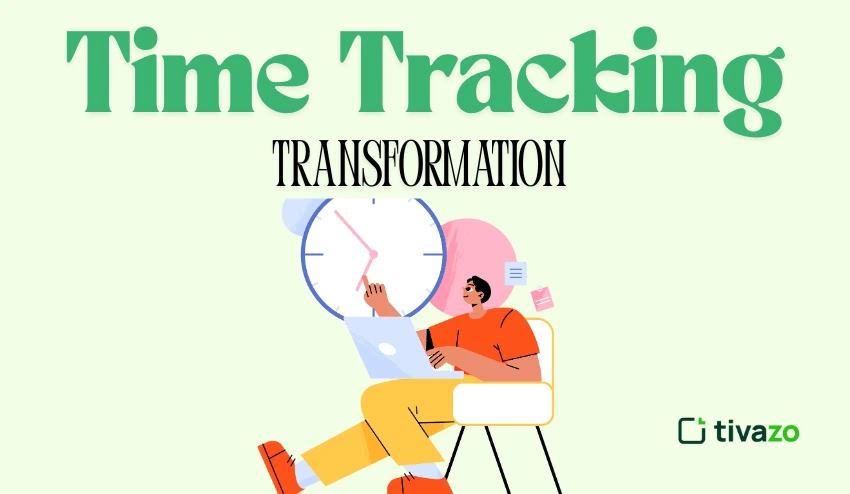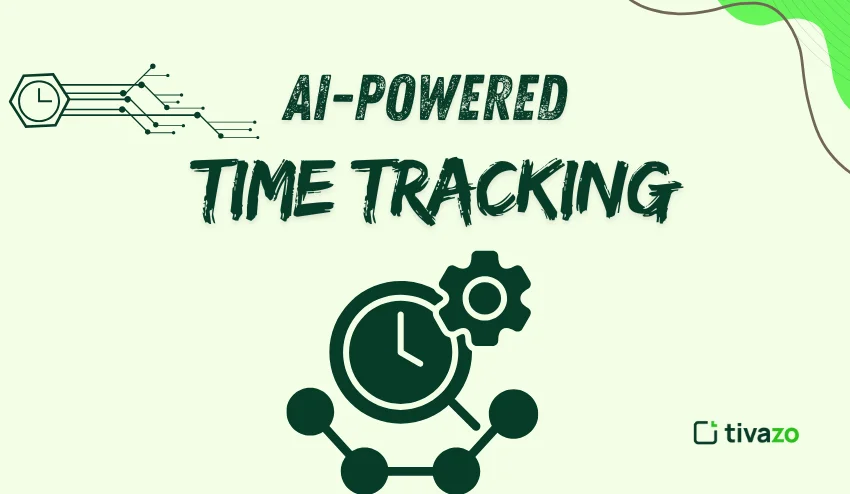In our fast-paced and digitally transforming world, organizations are being pressured to increase productivity, improve efficiency, and utilize resources effectively. For CIOs (Chief Information Officers) and technology leaders, time-tracking transformation has moved away from being an afterthought and has become more of a business priority. Legacy systems, manual processes, and fragmented workflows are contributing to missed deadlines, budget variances, compliance risks, and poor visibility into workforce productivity.
This blog will discuss the ultimate CIO’s checklist for a successful time-tracking transformation, including the opportunity AI-enabled solutions create, considerations to take into account when assessing which platform to choose, examples from the real world, such as Capgemini, and how Tivazo can be a game-changer for organizations starting their journey.
How Time-Tracking Transformation is Important to CIOs
Time may be the most precious business asset, yet many organizations still trivialize it as a back-office administrative task. The cost of the inability to execute the time-tracking transformation is catastrophic. If companies do not invest in time tracking, it will lead to lost opportunities, inefficient resource utilization, and a lack of workforce visibility. When CIOs adopt time-tracking transformation, it promotes data-driven decision-making, actionable forecasting, and frictionless compliance functions.
Additionally, new solutions enable an organization to eliminate human error, enhance employee engagement, and connect operations to corporate goals through real-time performance indicators. Don’t settle on the legacy of yesterday’s rigid time tracking regime – time tracking transformation elevates your business strategy, revenue-driving
Common Challenges CIOS Work Through
- Missed deadlines: Lack of insight into the progress of tasks can lead to missed deadlines.
- Cost overruns: Poor time tracking increases operational costs and can detract from profitability.
- Compliance risks: Manual reporting increases the opportunity for human error and violations of labor laws.
- Revenue leakage: Low accuracy in billing means organizations cannot invoice potential revenue, a challenge that is particularly relevant in client-facing industries.
- Employee burnout: Employees are disengaged because they tire of the time-consuming, manual processes.
Given these challenges, CIOs have no other option but to identify digital transformation efforts that include modernizing time tracking at the core.
The Strategic Responsibility of CIOs in Leading Time-Tracking Transformation
CIOs do not simply direct technology strategy and implementation; they are transformation leaders. Transforming time-tracking successfully requires a strategy and vision that aligns with business outcomes, including:
- Workforce Productivity Optimization
- Better Insights, Enhanced Decision-Making, and Real-Time Data
- Global Solutions with Scalability
- Enhanced Employee Experience
- Better Control Over Financial and Operational Effectiveness
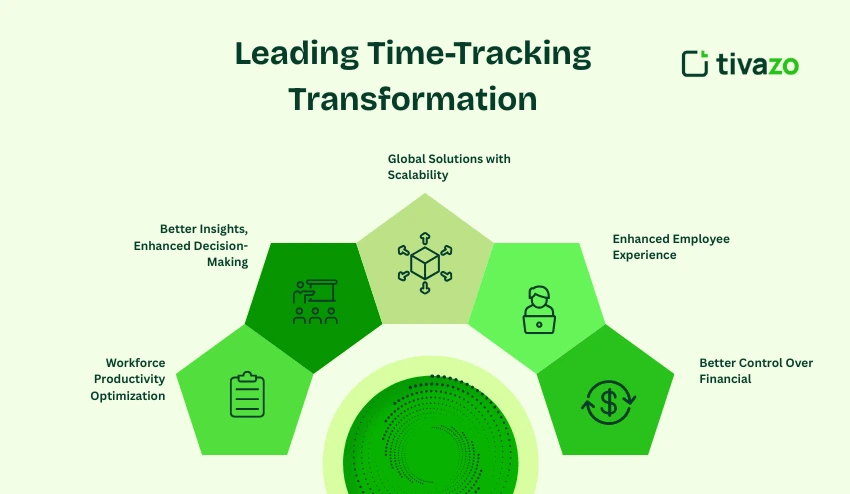
CIOs must keep their eyes on
- Be the Enterprise-Wide Champion: The CIO must be the champion for time-tracking transformation across all departments within the organization, ensuring that everyone uniformly uses it in conjunction with other digital tools.
- Strengthen Data Governance: A modern time-tracking transformation will give the CIO compliant, structured data for auditing, financial reporting, and forecasting future business
- Enable IT and Business Strategy Integration: Time-tracking transformation enables the CIO to ensure that IT investments yield measurable outcomes from a business standpoint.
- Enable Innovation and Agile Delivery: Beyond just providing documentation for time spent on projects, the business value in the time-tracking transformation is in allowing employees to become less involved in a traditional, manual time-entry.
- Time-tracking transformation will allow teams to be more innovative and receptive in a dynamic market.
- Transparency: Employees need to know where their time is being spent and have real-time visibility into resource allocation, so executives and managers can make the best decisions to advance the business.
CIO Checklist for Successful Time-Tracking Transformation
Here’s a structured checklist for CIOs to establish the goals, objectives, gain organizational buy-in, plan, etc., for a time-tracking transformation.
1. Create Strategic Objectives
- What are the ultimate objectives— cost savings, productivity, compliance, client billing accuracy, etc?
- What are the organization’s growth objectives, and how will time-tracking assist?
2. Determine the Gap
- Which departments or processes today are still doing manual tracking?
- Are there any bottlenecks in project management, payroll, or billing?
3. Investigate AI-Powered Automation
- How can artificial intelligence auto-populate timecards from calendars, project tools, and collaboration apps?
- What productivity improvement will automation create?
Tip: Boost your growth engine by integrating AI lead generation, enabling your team to identify high-potential prospects while managing time-tracking transformation.
4. Choose Your Platforms
The table below will help you guide decisions:
| Criteria | Why This Matters |
| Accuracy | Ensures billing and payroll processes are correct |
| Scalability | Facilitates growth across regions and based on workforce type |
| Flexibility | Accommodates hybrid, remote, or gig-class work arrangements |
| Analytics | Gives additional insight you can use to make more informed decisions |
| Compliance | Ensures compliance with local and international labor regulations |
| Integration | Integrates with HR management systems, ERPs, and project management systems |
| Cloud/Web Ready | Accessible from anywhere in the world, at any time |
| Employee Experience | Best user experience with self-service and simple-to-use features |
5. Generate Change Management Campaigns
- Awareness internally morphs to adoption.
- Example: Capgemini’s “One Minute. Once a Week” campaign increased adoption to 100%.
6. Monitor ROI and Business Outcomes
- Revenues per employee increase
- Reduction in admin overhead/project resource time
- Improved compliance reporting
- Increased client satisfaction
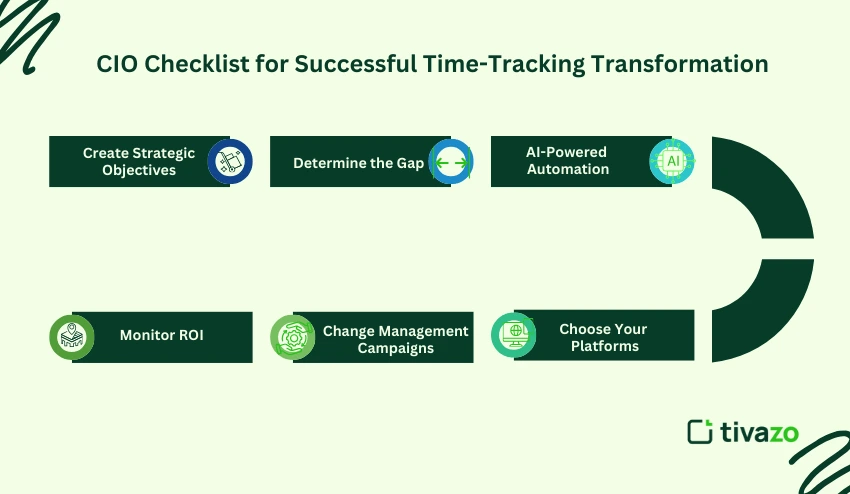
Real-World Example: Capgemini’s Success Story
Capgemini had a big win on productivity by consolidating 17 independent time-tracking systems into their new time-tracking platform, which is called Timestamp. Their internal campaign, “One Minute. Once a Week,” encouraged employees to update their timesheets for a mere 60 seconds for one day a week.
The Results:
- Almost 100% timesheet usage
- Reduced administrative effort
- Greater accuracy in billing and payroll
- Cost savings and efficiencies
This case illustrates how CIOs can deliver great value when combining the right tool with good change management. Capgemini’s journey also illustrates the wider benefits of creating a time-tracking transformation for global businesses. Instead of utilizing separate tracking systems, they simplified their time management efforts with one tool, allowing them real-time visibility across their entire workforce.
Time-tracking transformation has many implications beyond timesheet adoption, including compliance, billing accuracy, and operational controls. For CIOs, tracking time is a demonstration of value that produces a measurable ROI, encourages employee accountability, and offers a sustainable opportunity to gain efficiencies. Organizations that successfully pursue time-tracking transformation can realize similar outcomes as Capgemini and position themselves for improvement at scale.
How Tivazo Drives Time-Tracking Transformation
While there is a plethora of time tracking options, none of them have taken an advanced, employee-centric approach like Tivazo. Tivazo was built for the modern-day organization and provides CIOs with the tools needed to successfully lead a transformation.
Key Features of Tivazo
- Automated Time Capture: AI-driven auto-fill functionality through our seamlessly integrated tools.
- Industry-Specific Workflows: Departments can set customized workflows and documentation layouts for their
- Geographical location or industry: consulting, IT services, or professional services, etc.
- Advanced Analytics: Provides insight into what staff are completing and what chemicals are succeeding with their work output.
- Compliant: Built-in compliance with global labor laws.
- Seamless integrations: Tivazo works with HR, ERP, payroll, and project management platforms.
Cloud-based and Desktop Capable: Enterprise-ready to ensure a secure and scalable solution for global enterprises.
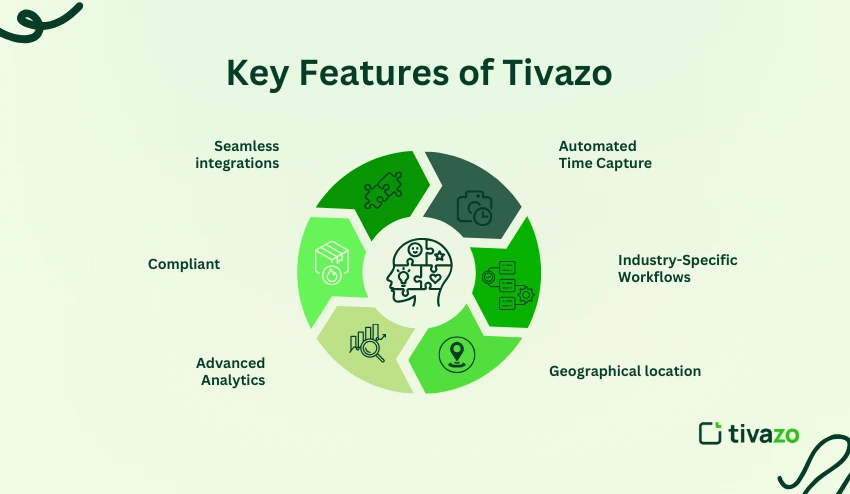
Advantages of Using Tivazo
| Advantage | Effect on Business |
| Reliable Time Data | Avoids revenue leakage and payroll mistakes |
| Reduced Manual Work | Moving employees from repeated data entry to high-value work |
Real-Time Information | CIOs and managers can make decisions driven by data |
| Better Compliance | Mitigating risk |
| Greater Employee Engagement | User-friendly interface supports take-up by employees |
| Improved Productivity | Team members stay aligned with project goals and deadlines |
The Risks of Postponing Time-Tracking Transformation
To postpone modernization can have severe effects:
- Revenue Loss: Mistakes in invoicing 67% of PSOs (Professional Services Organizations), risk market share if they fail to modernize.
- Compliance Fines: Mistakes in labour reporting 75% of CIOs believe that modernizing now will allow them to remain competitive.
- Less Engagement: Employee productivity will suffer from using outdated tools.
Research shows:
- 67% of PSOs (Professional Services Organizations) risk losing market share if modernization fails.
- 75% of CIOs believe that competitors will overtake them if modernizing fails, rookies can be as effective they can go faster.
These statistics reinforce that what appears to be a technical inconvenience to delay a time-tracking transformation is, in fact, a threat to growth and stability.
Organizations that do not focus on digital initiatives usually have the unwelcome resignations of employees, who do not feel visible from not being able to track billings, and therefore, poor decisions can arise. In this on-demand economy, if CIOs delay investing in a time tracking transformation and develop a digital strategy can protect profitability, ensure good compliance, and keep organizations in a forward position in a
Action Plan for CIOs: Transforming Time Tracking
Step 1: Further Assess Existing Time-Tracking Systems
- Assess current time-tracking methods in use (spreadsheet, legacy tools, traditional manual logs).
- Identify inefficiencies (for example, duplicate data entry or inaccurate reporting) and stumbling blocks concerning incorporating payroll or ERP.
- Talk to employees and managers about existing pain points/design challenges.
- Walk through the workflows to identify the touch points for delays, bottlenecks, or misreporting.
- Use this assessment as a point of reference when evaluating improvement after the transformation.
Step 2: Set Clear Objectives
- Align objectives to broader business outcomes (cost savings, compliance, employee engagement).
- Establish measurable KPIs (accuracy of client billing, efficiency of payroll process steps, user uptake).
- Prioritize objectives based on, for example, improving workforce productivity, better forecasts, and better decisions.
- Establish target benchmarks for improvement to measure success.
Step 3: Choose a Suitable Technology Platform
- Choose a modern, from-the-ground-up AI time-tracking solution (for example, similar to Tivazo) that integrates with payroll, HR, and project management.
- Confirm the solution is a scalable technology if you want to take your company global.
- Choose vendors based on usage, compliance, and data security protocols.
- Implement and test the solution in one department or unit before receiving it as “Mainstream”.
Step 4: Accept Change Management
- Communicate the benefits for employees and managers clearly.
- Given competencies, use hands-on training, FAQs, and user support.
- Run adoption campaigns to improve engagement.
- Listen during rollout and improve management planning over time.
Step 5: Monitor and Optimize
- Track KPIs continuously to establish success.
- Utilize analytics to gain insights into project profitability, employee utilization, and operational efficiency.
- Over time, improve workflows and automation functionality
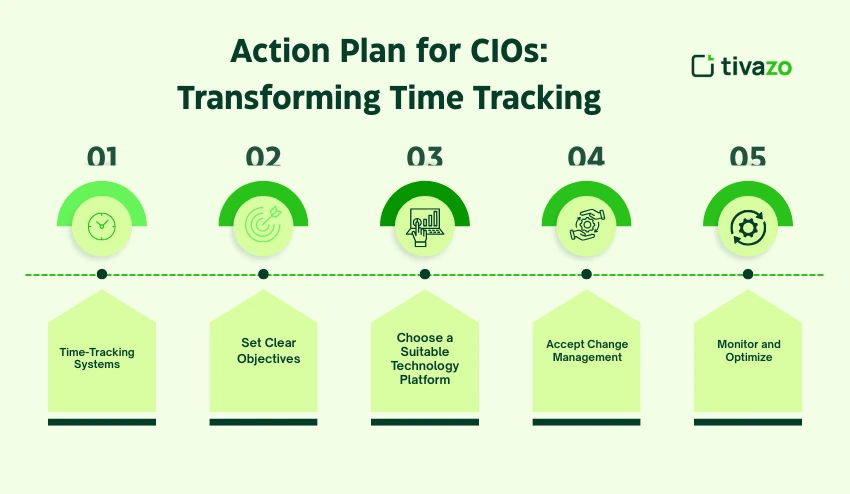
Conclusion
CIOs can no longer afford to overlook the time-tracking transformation that has already begun in today’s increasingly fast-paced digital economy. What was once considered a trivial back-office administrative process is now seen as a structural transformation that can affect revenue, compliance, and ultimately workforce productivity. It is imperative that a CIO is driving a structured time-tracking transformation so they can have real-time visibility in the operations of their organization, reduce inefficiencies, and empower employees with more intelligent, intuitive tools.
When looking at examples of successful organizations, it is easy to see that with the right platform, shared vision, and leadership, organizations can achieve tangible results — including cost reductions, improved decision making, etc. Time-tracking transformation can no longer be considered optional if organizations expect to remain competitive in a landscape where data-driven insights and flexibility are essential.
For CIOs, the checklist is simple. Understand existing systems, establish your desired business outcomes, determine the appropriate technology, ensure you have a good change management approach in place, and continue to optimize. Organizations that do this now will future-proof their place in the digital transformation space
